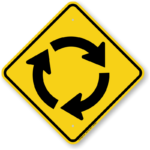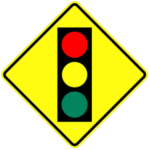Frequently Asked Questions
In an effort to provide responses to the most frequently received comments/questions, we have compiled the following list of questions/answers:
Will pedestrians be able to cross CH 21 at Main Ave?
Yes! Pedestrians can expect to cross CH 21 at Main Avenue safely with less than 15 seconds of delay. A pedestrian activated flashing beacon will be used for this new two-stage crossing.
How well does a roundabout handle the traffic volumes on CH 21 and TH 13?
A roundabout at the CH 21 and TH 13 intersection is expected to provide improved traffic operations during the busiest times of the day during both day of opening and in the year 2040 compared to the traffic signal alternative (with the addition of turn lanes). A roundabout is projected to provide upwards of 75% less wait times opening day and 20-60% less wait times with expected 2040 traffic volumes compared to a traffic signal. The benefit of a roundabout is also observed during off-peak hours where vehicles won’t be required to wait at a red light when opposing traffic is light.
How safe is it for pedestrians to cross at a multi-lane roundabout when compared to a traffic signal?
 The vehicular yield rate for pedestrians at a multi-lane roundabout is around 45% – this means that approximately half of motorists will stop for a pedestrian waiting to cross at the crosswalk. The expected wait time for a pedestrian to begin crossing a multi-lane roundabout is approximately 10 seconds. The center median on each leg of the roundabout allows pedestrians to cross one direction of vehicular traffic at a time, but the two approach lanes can potentially create a blind spot for drivers seeing a pedestrian waiting to cross. The yield rate at multi-lane roundabouts can be improved with the use of appropriate signage and additional awareness measures such as pedestrian activated flashing beacon..
The vehicular yield rate for pedestrians at a multi-lane roundabout is around 45% – this means that approximately half of motorists will stop for a pedestrian waiting to cross at the crosswalk. The expected wait time for a pedestrian to begin crossing a multi-lane roundabout is approximately 10 seconds. The center median on each leg of the roundabout allows pedestrians to cross one direction of vehicular traffic at a time, but the two approach lanes can potentially create a blind spot for drivers seeing a pedestrian waiting to cross. The yield rate at multi-lane roundabouts can be improved with the use of appropriate signage and additional awareness measures such as pedestrian activated flashing beacon..
 The vehicular yield rate for pedestrians at a traffic signal is considered to be near 100% – this means that nearly all cars will stop for a pedestrian crossing the crosswalk when the signal is red in their direction and the walk sign is on. The expected wait time for a pedestrian to begin crossing a traffic signal is 60-90 seconds. The controlled intersection allows for designated crossing times for pedestrians, however the long wait times can potentially increase the occurrence of jaywalking.
The vehicular yield rate for pedestrians at a traffic signal is considered to be near 100% – this means that nearly all cars will stop for a pedestrian crossing the crosswalk when the signal is red in their direction and the walk sign is on. The expected wait time for a pedestrian to begin crossing a traffic signal is 60-90 seconds. The controlled intersection allows for designated crossing times for pedestrians, however the long wait times can potentially increase the occurrence of jaywalking.
How do I navigate a multi-lane roundabout?
How is downtown Prior Lake expected to develop?
The City of Prior Lake 2040 Comprehensive Plan Update is currently underway with an updated land use map outlining town center, transitional town center, and mixed-use zones. More information regarding the Comprehensive Plan update can be found on the Prior Lake Website.
What is a Primary Intersection? Secondary?
A primary intersection provides full access to a broader geographical area by providing a connection in the roadway system. Full access would be maintained in all directions – all movements can be made, left and right turns as well as thru movements. Examples of traffic control at primary intersections include, traffic signals, roundabout, all-way stops, and some two-way stops.
A secondary intersection provides access to a more localized area or individual properties. A secondary intersection may have restricted movements in one or multiple directions. Examples of traffic control at secondary intersections include, thru-stops, Right-in/Right-out, and ¾ access (left and right turns provided, thru movements restricted).
Why can’t all the intersections be full access (primary intersections)?
The greater number of access points on a roadway corridor correlates directly with a decrease in corridor mobility and an increase in expected crash rates. Corridor Access Management designates where and how vehicles enter and exit an area. The number of access points in a downtown environment needs to maintain a balance between reducing the risk of user conflicts while serving the circulation needs of local businesses and residences. A mix of primary and secondary intersections is needed in order to sustain acceptable delay, preserve mobility and property access, and minimize crash problems.
